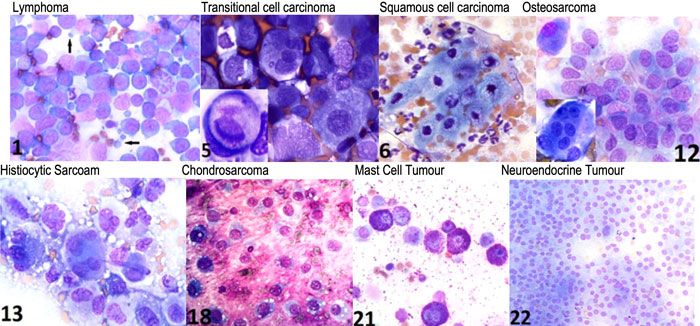UCD Research - August 2023
Diagnoses of Canine Cancer by Cytology in Ireland
Peter James O’Brien head of clinical pathology, and his former residents report on a review of the cytologies diagnosed in the Clinical Pathology Laboratory at the School of Veterinary Medicine. Clinical Pathology residents involved in these diagnoses and research were: Inese Berzina, Margarida Domingos, Stratos Papakonstantinu, Maria Balan, Eve Ramery, Javier Martinez, Andrada Fotea
In association with


Peter James O’Brien
Head of clinical pathology
Objective and method
1,000 cases of neoplasia that had been diagnosed in dogs by cytology at the clinical pathology laboratory of the UCD School of Veterinary Medicine over a seven-year period were analysed to determine the most common types of cancers and to estimate their frequency of occurrence versus benign tumours. Neoplasias were categorised according to standard veterinary criteria as either epithelial, mesenchymal or round cells. Malignant tumours, cancers, were categorised as carcinomas, sarcomas, or malignant, round cell tumours. Neuro-endocrine tumours (NET) were categorised separately. Many cancers were further sub-categorised based on having unique morphological features.
Results
Most of the cases of neoplasia, 57 per cent, had been admitted to the UCD University Veterinary Hospital. However, 43 per cent were cases for which smears had been submitted from external, private practices.
Benign tumours: The most common neoplasia was benign, the lipoma, accounting for 31 per cent of all neoplasias examined cytologically. An additional 10 per cent of neoplasias were benign tumours, comprised of 4.3 per cent adenomas of which half were in the perianal gland, 3.3 per cent histiocytomas, 2.1 per cent haemangiopericytomas and 0.4 per cent each of haemangios and fibromas. Benign tumours were more commonly submitted by external practices, at a two-fold higher frequency for lipomas and histiocytomas, and four-fold for haemangiopericytoma.
Cancer: The most common, cytological category of malignant neoplasia was the round cell tumour. Lymphoma was by far the most common, accounting for 23 per cent of all neoplasias examined. The lymphoid, plasma cell tumour was categorised separately and comprised 0.9 per cent. The second most common was the mast cell tumour, at 10 per cent. Carcinomas and sarcomas each comprised 12 per cent neoplasias. In contrast to the case for benign tumours, these were submitted three times more commonly from the UCD hospital than from external practices. Of the carcinomas that were specified according to type based on unique morphological features, one-quarter were transitional cell, and one-tenth were squamous cell. Thyroid adenocarcinomas anal sac apocrine gland adenocarcinoma occurred much less frequently, but were classified amongst the NET tumours, which comprised 1.8 per cent neoplasias. Within the category of sarcomas, subcategorisation was more common. There were 18 per cent sarcomas identified as osteosarcomas, 15 per cent as histiocytic sarcomas, 8 per cent as liposarcomas, 6 per cent as haemangiosarcomas, 5 per cent as fibrosarcomas, 5 per cent as melanosarcomas, and 4 per cent as chondrosarcomas.

Discussion and conclusion
Mildly more than half of tumours diagnosed by cytology at this Clinical Pathology laboratory are malignant. By far most common is the lymphoma, then with each occurring at half this frequency, there is the mast cell tumour, carcinomal and sarcoma. With the exception of lymphoma and mast cell tumour, our lab receives substantially fewer cases of cancers from external practices than our UCD hospital. However, substantially more benign tumours are submitted from external practices. By far the most common benign tumour seen is the lipoma. Details of this study are being prepared for publication.
In association with


Peter James O’Brien
Head of clinical pathology
















